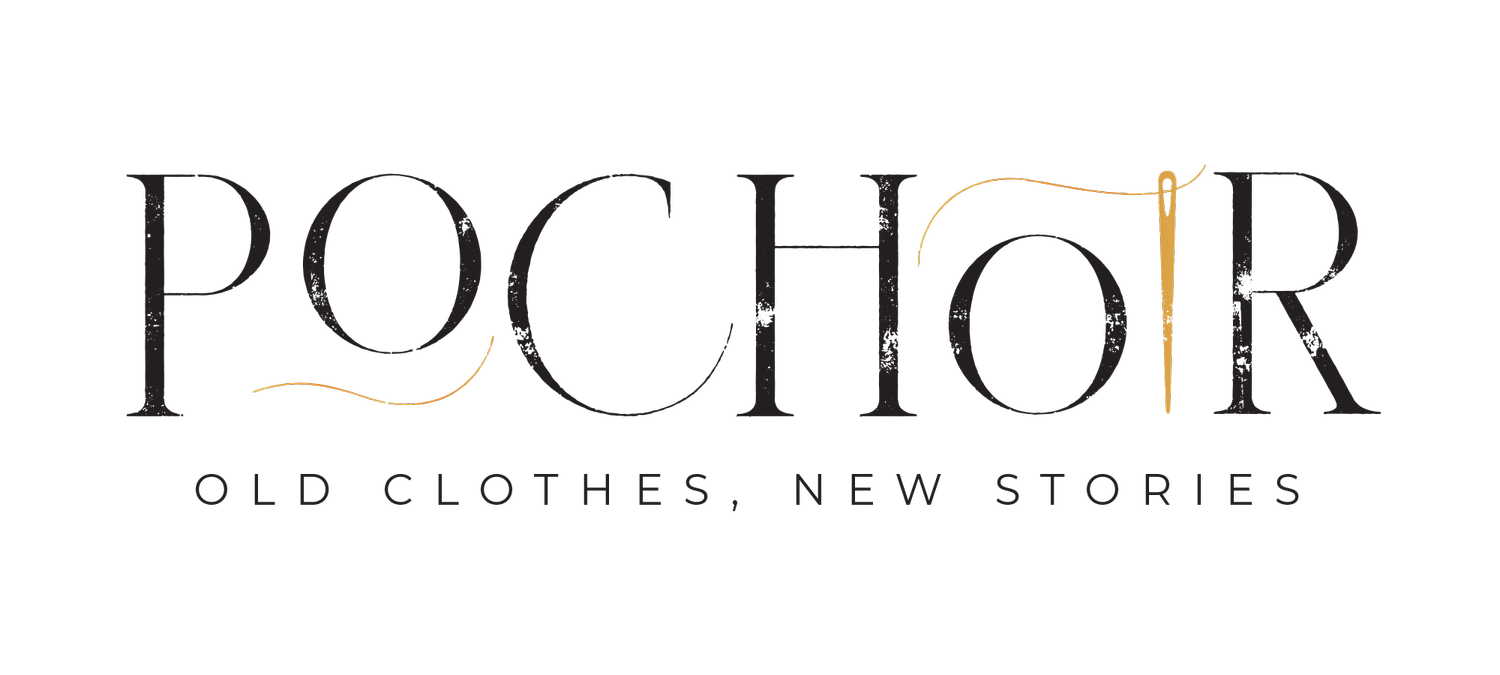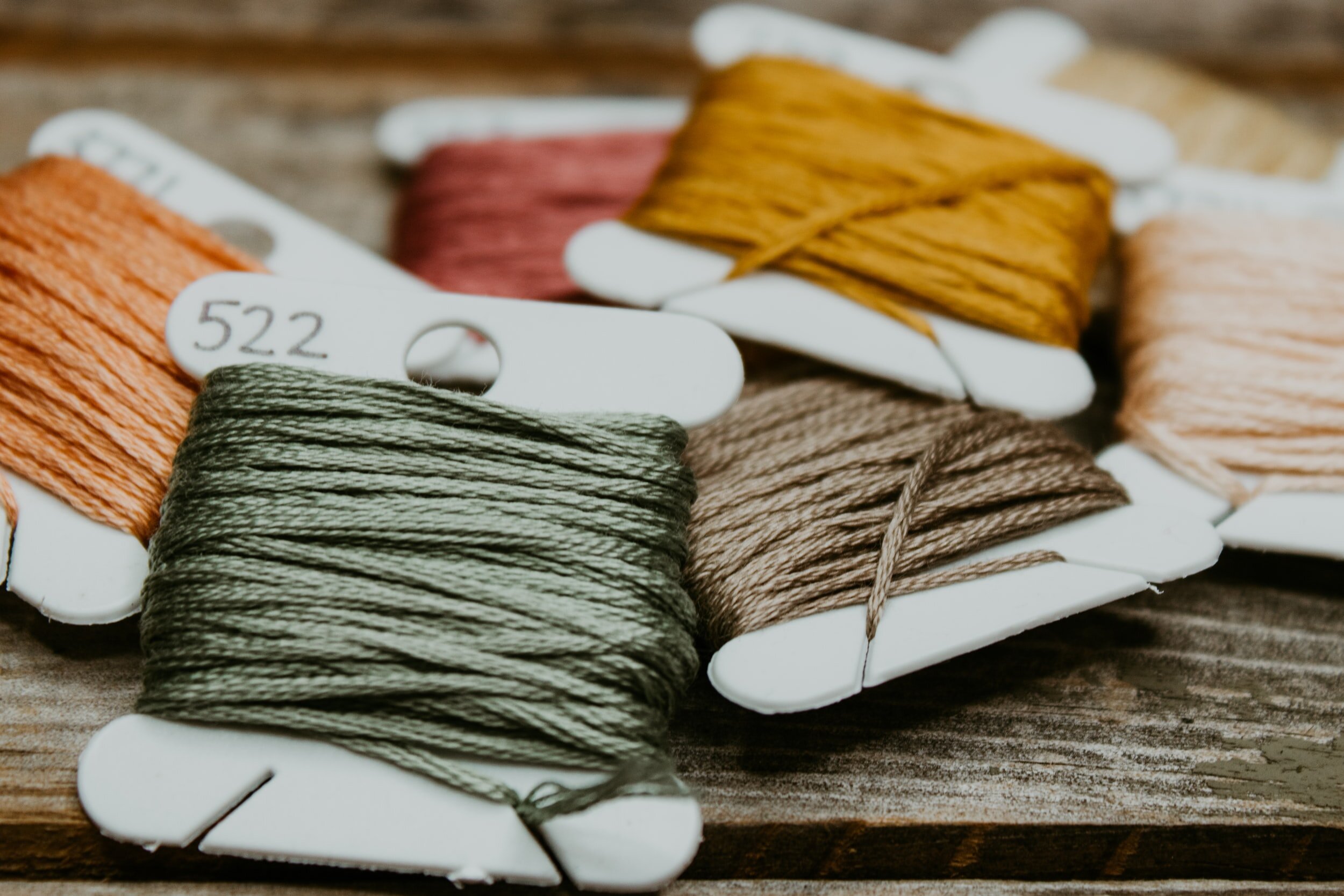Our Materials
Photo of embroidery thread neatly wrapped around plastic bobbins. The thread colors are (clockwise from top) red, gold, tan, sage green, and orange.
One of the great things about sustainable design is that it encourages people to collaborate. Since the sustainable fashion and textile industries are so small, I hope that this list becomes a useful and ever-growing resource for people who wish to practice sustainable textile crafts and own e-commerce businesses.
Fabric & Clothes
Cloud 9 Cirrus Solid Fabric—Perfect fabric for embroidered hoop art. This fabric is not only beautiful but it was the only GOTS-certified cotton fabric that I could find that came in multiple stock colors. “Stock” meaning that none of the colors are made to order and that the company always has the colors available. GOTS is a certification given to cotton that is grown and processed in an ethical way and is not mixed in with standard cotton in the milling process. What I love about the Cirrus fabric is that it’s yarn-dyed, meaning that the individual strands of fiber are dyed before the fabric is woven, giving the fabric a beautiful streaked effect that resembles linen. Since I embroider with cotton thread, this makes my designs fully recyclable. Cloud 9 posts the GOTS certificate for the fabric on its website, ensuring that anyone who wants to know can see that the fabric is from India and processed in Pakistan, free from forced Uighur labor in China.
FABSCRAP—FABSCRAP is an incredible NYC-based organization that collects fabric waste from designers in New York City and resells this upcycled fabric to students, small designers, crafters, and anyone who loves going into a fabric store never knowing what they’re going to find. When I am not using Cirrus fabric, I exclusively use upcycled fabric. FABSCRAP does not keep records of the fiber content of the fabric it collects, so when I list fiber content on the back of my work, I try to make my best guess. FABSCRAP has a great online store and they are working to expand to other cities so stay tuned! According to their site, FABSCRAP has already saved over 500,000 pounds of fabric from landfills.
Muslin—I source all of my organic muslin from OrganicCottonPlus.com While not all of their organic muslin qualities are certified organic, I am able to pick the country of origin. I only buy muslin from India to avoid the possibility of forced Uighur labor.
ThredUP—My main source for clothing that I want to embroider. I find that it’s really useful to be able to sort by size and color, especially since a lot of thrift stores in New York City don’t go above a size XL.
The Sustainable Fashion Community Center (SFCC)—One of my favorite clothing swaps in New York City! Located in East Harlem, the swap at the SFCC is run by the New York City Fair Trade Coalition, an advocacy group of fashion, accessory, home good designers, and artists who are committed to sustainable and fair trade principals. (I am a proud member.)
Supplies and Notions
Bamboo Hoops—I only use unstained bamboo hoops in my work in an effort to keep all supplies as recyclable, biodegradable, or compostable as possible. Bamboo is considered a sustainable material because it grows back so quickly after getting cut down. I alternate between buying bamboo hoops from DMC and from Michael’s (which I suspect are actually the same as the DMC hoops but half the price).
Floss
DMC—I mostly work with classic, tried-and-true DMC embroidery thread. One of the great things about DMC thread is that it is OEKO-TEX certified, meaning that the dyes are free from toxic chemicals and the working conditions in the processing plants in France are safe and ethical. Unfortunately, DMC does not say on its site where the cotton comes from or in what conditions it is farmed. When buying floss, I always try to shop local and mainly get my floss from Daytona Trimmings, a mainstay in New York City’s Garment District.
Papirami—Papirami is a fellow Etsy seller located in Spain offering sets of beautiful organic Peruvian cotton embroidery floss. Her site claims that the cotton is organic and hand dyed, but without any certification it’s hard to know under what conditions the floss is made. Her color system follows DMC’s and I found the floss beautiful and very easy to use. The texture is slightly more coarse than that of DMC thread—understandable, since the staple (cotton fluff that gets spun into yarn) in an organic cotton plant will have a more variegated length than the presumably GMO cotton that DMC uses. The longer the staple, the smoother the yarn. Given the cost and the relative carbon footprint of sending the floss all the way from Peru to Spain back across the Atlantic to North America, I am using this beautiful floss sparingly but you shouldn’t have to!
ThreeHeartsDesignCo—ThreeHeartsDesignCo is another wonderful seller I found through Etsy. She takes DMC cotton floss and perle thread and overdyes them with all-natural dyes made from fruits, leaves, bark, and berries, creating beautiful, bright, variegated colors you won’t find anywhere else.
Needles—There aren’t exactly ethically made needles (that I can find anyway). I mostly use DMC brand or whatever brands Daytona Trims carry.
Stabilizer—Because I am making my designs over and over, instead of tracing them onto fabric, I have found it easiest to print my designs on water soluble stabilizer called Sulky Solvy. The stabilizer feels like paper but is actually made from starch and glue that dissolve in hot water.
Ribbon—I offer an optional organic, naturally dyed cotton ribbon as an add-on. The company is called Botanica Tinctoria and the ribbon is for sale on OrganicCottonPlus.com The company says that the ribbon is dyed in a close looped system by hand using natural dyes, meaning that any waste produced in the process of making the ribbon (such as water leftover after dyeing the ribbon) is recycled and reused. The ochre ribbon I am offering was dyed with guava peel.
Packaging
Packing Materials—I proudly use shipping products from EcoEnclose, which offers a wide variety of affordable, environmentally friendly packaging options. I use several different options: for my embroidered hoop art, I use a plastic mailer made from recycled plastic and a recyclable plastic sealed pouch bag. However, I will eventually phase these out as they can only be recycled in plastic film recycling streams, which are uncommon. I also use paper mailers and wax paper bags for my clothes. The mailer and protective bag are made from recycled paper and recyclable.
Stickers and Shipping Labels—These are also from EcoEnclose and made from recycled paper. The liner paper for the stickers can be sent back to EcoEnclose to be recycled in a special process while the liner paper for the shipping labels are recyclable in any municipality.
Postcard—Each package includes a postcard with sustainable shopping tips and a coupon code. I bought them through PSPrint, which prints on recycled paper and uses soy-based inks that eliminate water use. They also have several printing plants and print your project at the one closest to you to reduce fuel usage and shipping costs.
Washi Tape—Okay, so the washi tape I use to decorate my packages and attach your receipts to the postcards isn’t exactly sustainably sourced (I got it from Michael’s) but I did some research and washi tape is indeed recyclable and biodegradable! So it counts as sustainable, right?

